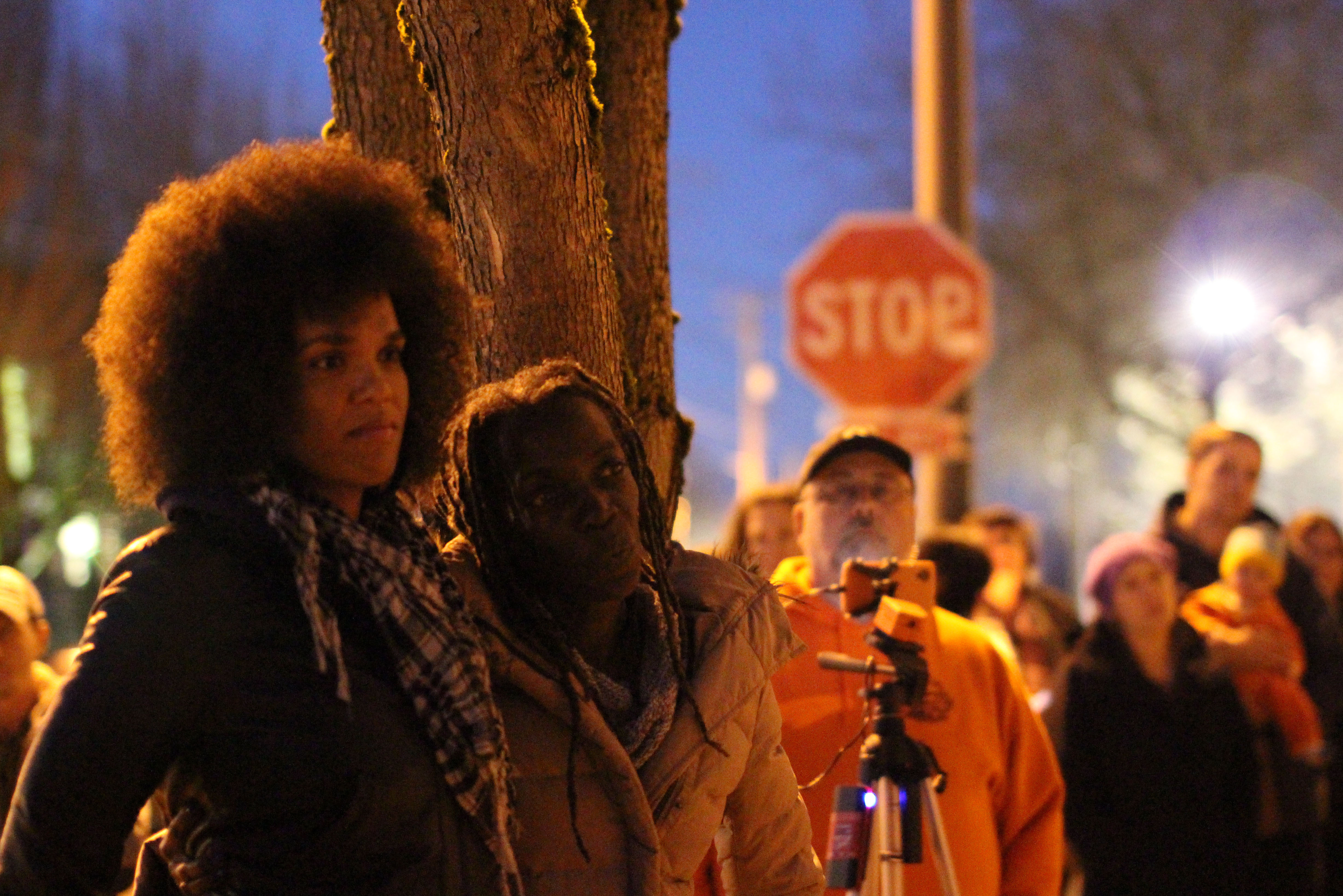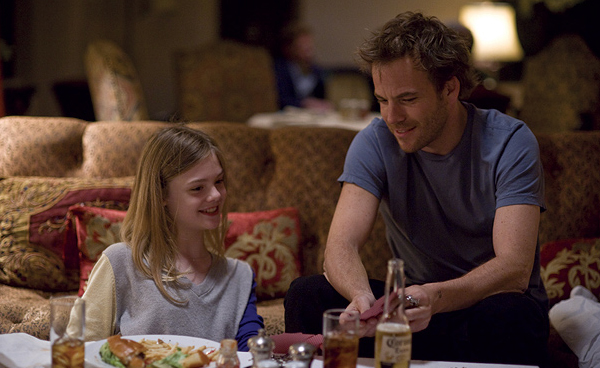The twelfth of the month held a special significance for Fred Bryant. Each month on that day, Bryant held vigil at the Northeast Portland site where his son Keaton Otis died at the hands of Portland police.
Otis died during a 2010 traffic stop near Lloyd Center, where police fired over 30 rounds on his vehicle after he allegedly pulled a gun. He was 25 years old.
Bryant and his fellow supporters debated the police narrative in the appeals process, but to no avail. Otis, they say, was targeted as a young, black male.
The police killed Otis just months after Aaron Campbell, also a black Portlander, was shot in the back by police sniper Ron Frashour during a call-for-assistance on a suicide threat. They were both killed two years before the fatal encounter in Florida between George Zimmerman and Trayvon Martin.
Martin’s death and Zimmerman’s subsequent acquittal ultimately precipitated the Black Lives Matter movement in protest of systematized violence against African-Americans.
Bryant sustained his monthly vigils until his own passing in Oct. 2013. But the community continues his work, meeting at NE 6th and Halsey in commemoration of Otis and Bryant on the twelfth of each month.
On a rainy Portland evening last Friday, supporters lit candles and discussed the next steps toward the pressuring the police for accountability.
“This is definitely about police violence, and the way that police control, contain and exploit communities of color,” said Walidah Imarisha, vigil organizer and associate professor of Black Studies at Portland State. “I think that in terms of the actual reality of police murders, unfortunately, [the situation] has stayed the same or increased [since 2010].”
The gathered crowd included social justice activists, concerned community members and friends of the deceased.
Frances O’Halloran-Haney, a friend of Otis’ family, recalled her last time seeing Keaton. She said that they talked about Otis’ recent trip to Canada and how he enjoyed the culture during his visit.
O’Halloran-Haney said she has continued to attend his vigils every month.
“I do it for him,” she said. “I know him, he was a good kid.”
Safety for whom?
Otis and Campbell’s deaths reflect how Portland situates in a broader conversation about police use of force and accountability in the United States, particularly against communities of color. They also illustrate the stakes felt by students of color at PSU, where officers have recently been armed in an effort to address security, both for the campus security officers and for the broader PSU community.
Student activists, including DisarmPSU and the PSU Student Union, have been recurrent and outspoken critics of the administration’s decision, going as far as taking disruptive action against PSU Board of Trustees meetings and other university functions in protest.
University administrators have said they seek to build an inclusive campus police force, and that the university has deployed firearms with such safety concerns in mind as active shooter scenarios.
Opponents argue that the administration’s concept of safety ignores the needs of black members of the PSU community, many of whom feel less safe in the presence of armed campus officers.
Jasmine Westmoreland, programming director for the Black Student Union, pointed out that the arming of campus police came up as a student concern repeatedly during a recent Black Caucus held by the union.
“[Many] black students feel that the campus has no regard for them or their safety in general,” Westmoreland said. “They say that we don’t feel safe if you do this, and [the administration] went and did it anyway. Our concerns should be taken more seriously.”
Assistant Professor Roberta Hunte of PSU’s Black Studies Department talked about similar issues brought up in classes.
“From my classes, students are very unnerved by it, and feel they are being targeted,” Hunte said. “[They] feel dismissed by the administration. They feel that they are making their needs known, but around this particular issue, it’s really an intractable issue.”
Repeated instances of police violence against black men throughout the country keeps this issue at the forefront, both on and off campus.
On Jan. 19, CNN reported that the University of Cincinnati settled a lawsuit in the shooting death of Samuel DuBose, totalling about $5.35 million, including $4.85 million to the family and free undergraduate education for DuBose’s 12 children. DuBose was shot to death by university officer Ray Tensing on July 19 during a routine traffic stop.
During the Otis vigil, organizer and activist Jo Ann Hardesty referenced another killing of a black male youth by law enforcement in Oregon. Oak Grove resident Christopher Kalonji was killed on Jan. 28 by Clackamas County sheriff’s deputies after allegedly threatening family members with a rifle during a mental health crisis, according to reporting by The Oregonian.
Kalonji’s parents, Tony and Irene, disputed accounts that they were under any threat by their son in a Feb. 2 interview with KPTV.
“This family just buried their son yesterday,” Hardesty said. “We leave families in this devastated state over and over and over again.”
Despite tragedy, community prevails
But communities, both at PSU and the broader Portland community, resolved to stand together. Imarisha hailed the work of community members in keeping the vigil alive. Hardesty and Imarisha, along with Otis’ sister Alyssa and community members like O’Halloran-Haney, make it to 6th and Halsey on the 12th of every month they’re in the city.
Imarisha pointed to that spirit of community connecting PSU to efforts throughout Portland, and Portland to ongoing national efforts.
“I think that what is really incredible and powerful is the resistance movement to it, and seeing, nationally, Black Lives Matter organize themselves,” Imarisha said. “And seeing Black Lives Matter Portland being born, and seeing the organizing work on PSU’s campus, and seeing that tied together with the work in the community is incredibly powerful, so it’s not isolated.”
And in some ways at PSU, students have made progress. After students rallied at a December Students of Color Speak Out to make demands of the university, President Wim Wiewel took steps to ensure the opening of cultural resource spaces for Black and Asian-Pacific Islander students.
Westmoreland lauded La Casa Latina in particular for their support, and acknowledged broader support from administrators, including Director of Cultural Centers Cynthia Gomez, Program Coordinator Pedro Gomez, and Vice President of Enrollment, Management and Student Affairs John Fraire.
“Right now we want African diaspora to feel like they have a place to go, like La Casa Latina and the Native Student Center,” Westmoreland said. “So we’re definitely very excited.”
Westmoreland said Black Student Union members agreed on the importance of addressing the arming of campus police, and supported the efforts of activists like PSUSU. But she acknowledged that BSU is currently focused on building community through outreach events and the establishment of the new cultural space.
Imarisha also said movement toward justice involved a multi-pronged approach, such as community building and direct action. She pointed to the site of the vigil as an important space for remembering lost loved ones, and for bringing community together.
“I think it’s incredibly important for folks to be engaging on all levels, and in this space, we can come and really ground ourselves in the reality that these folks are not just names to be shouted or be put on posters,” Imarisha said. “They are loved ones, they are community members. There is a giant hole in our community where Keaton Otis should be.”
As Fred Bryant began on June 12, 2010, the community followed on the corner of 6th and Halsey. Community members each shared their reasons for attendance and discussed next steps on the march to social reform. They pointed to upcoming elections and the need to push for a Charter Review Commission, which could update the City Charter as a means of change.
“It’s only going to happen if the community demands it,” Hardesty said. “What a great opportunity we have during the campaign season.”
They promised the vigil would continue, as it had without fail since Otis’ death.
“It’s amazing that it’s been going for five years,” Imarisha said. “We’ve never missed a month as a vigil, and that is due entirely to the spirit and the leadership of [Otis’] father.”
Hardesty was moved by the show of support within the community to keep alive the spirit of Keaton Otis and Fred Bryant. She recounted one vigil when she hurried to the corner behind schedule, only to find a bursting community of vigil-holders waiting and ready to welcome her.
“No matter what, I know people will be on this corner,” Hardesty said.







